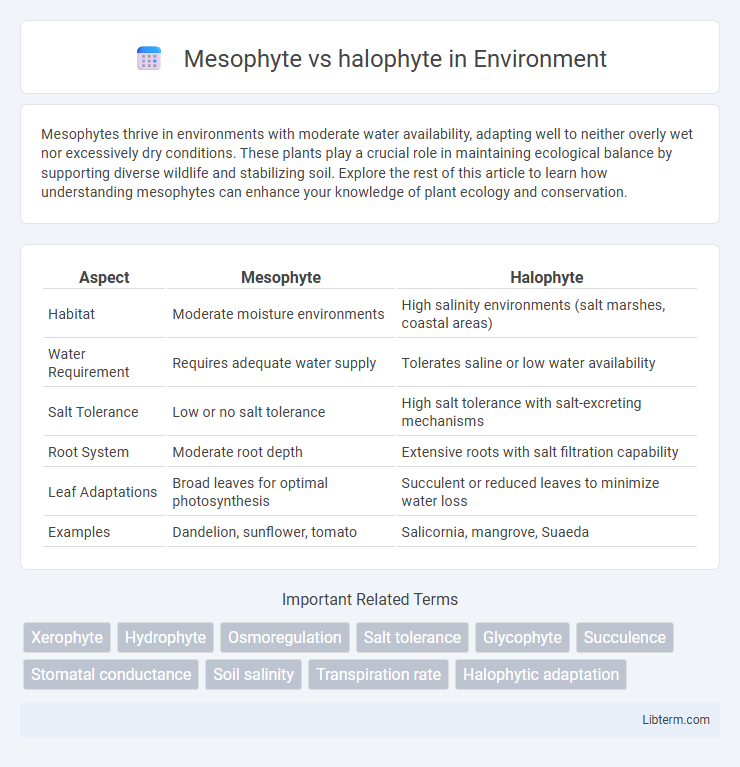Mesophytes thrive in environments with moderate water availability, adapting well to neither overly wet nor excessively dry conditions. These plants play a crucial role in maintaining ecological balance by supporting diverse wildlife and stabilizing soil. Explore the rest of this article to learn how understanding mesophytes can enhance your knowledge of plant ecology and conservation.
Table of Comparison
| Aspect | Mesophyte | Halophyte |
|---|---|---|
| Habitat | Moderate moisture environments | High salinity environments (salt marshes, coastal areas) |
| Water Requirement | Requires adequate water supply | Tolerates saline or low water availability |
| Salt Tolerance | Low or no salt tolerance | High salt tolerance with salt-excreting mechanisms |
| Root System | Moderate root depth | Extensive roots with salt filtration capability |
| Leaf Adaptations | Broad leaves for optimal photosynthesis | Succulent or reduced leaves to minimize water loss |
| Examples | Dandelion, sunflower, tomato | Salicornia, mangrove, Suaeda |
Introduction to Mesophytes and Halophytes
Mesophytes are plants adapted to moderate environmental conditions with balanced water availability, thriving in habitats such as forests, grasslands, and agricultural fields. Halophytes are specialized plants that tolerate or require high salinity levels, commonly found in coastal marshes, salt flats, and saline soils. Both plant types exhibit distinct physiological and structural adaptations to optimize water use efficiency and ion regulation in their respective environments.
Defining Mesophytes: Characteristics and Examples
Mesophytes are plants adapted to moderate water conditions, neither too wet nor too dry, thriving in environments with balanced soil moisture. Characteristic features include well-developed root systems, broad leaves with stomata for efficient gas exchange, and absence of specialized salt-excreting glands. Common examples of mesophytes are oak trees, beans, and sunflowers, which grow in temperate regions with adequate rainfall.
Understanding Halophytes: Key Features and Types
Halophytes are specialized plants adapted to saline environments, exhibiting unique physiological features such as salt excretion mechanisms, succulence, and osmotic adjustment to survive high salt concentrations. Key types include obligate halophytes that require salt for growth, facultative halophytes that tolerate but do not require salt, and recretohalophytes that actively secrete excess salt through glands. These adaptations distinguish halophytes from mesophytes, which thrive in moderate, non-saline habitats with standard water availability.
Habitat Preferences: Mesophytes vs Halophytes
Mesophytes thrive in environments with moderate water availability, typically found in forests, grasslands, and agricultural fields where soil moisture is neither excessive nor deficient. Halophytes adapt to saline habitats such as salt marshes, coastal dunes, and saline deserts, tolerating high salt concentrations that inhibit most plant growth. These distinct habitat preferences reflect their specialized physiological adaptations to water and salt stress.
Physiological Adaptations to Water Availability
Mesophytes possess moderate root systems and stomatal regulation enabling efficient water uptake and transpiration under balanced moisture conditions, optimizing photosynthesis without excess water loss. Halophytes exhibit specialized salt glands and succulent tissues that store water and excrete excess salt, allowing survival in high-salinity environments with fluctuating water availability. Both plant types adjust osmotic balance through compatible solutes like proline and glycine betaine, aiding cellular function during water stress.
Salt Tolerance Mechanisms in Halophytes
Halophytes exhibit advanced salt tolerance mechanisms enabling survival in high-salinity environments, unlike mesophytes which lack such adaptations. These mechanisms include salt exclusion at the root level, salt secretion through specialized glands, and osmotic adjustment by accumulating compatible solutes like proline and glycine betaine. Halophytes also compartmentalize excess salt into vacuoles, preventing cytoplasmic toxicity and maintaining cellular homeostasis.
Growth and Survival Strategies
Mesophytes thrive in moderate environments by optimizing water uptake through well-developed root systems and maintaining balanced transpiration rates to prevent dehydration. Halophytes exhibit specialized adaptations like salt excretion glands and cellular ion compartmentalization, enabling growth in high-salinity soils. Both plant types deploy unique physiological mechanisms to maximize survival; mesophytes focus on efficient water use, while halophytes emphasize salt regulation and osmotic adjustment.
Ecological Importance of Mesophytes and Halophytes
Mesophytes thrive in moderate environments with adequate water supply, playing a crucial role in maintaining soil fertility and supporting diverse terrestrial ecosystems by facilitating nutrient cycling and providing habitat for numerous species. Halophytes adapt to saline conditions and contribute significantly to coastal and salt-affected ecosystems by stabilizing shorelines, preventing erosion, and enhancing salt tolerance in vegetation communities. Both plant types support biodiversity and ecological balance through their specialized adaptations to distinct environmental conditions.
Agricultural and Environmental Applications
Mesophytes, thriving in moderate water conditions, are ideal for traditional agriculture due to their efficient water use and high crop yield potential in temperate environments. Halophytes possess unique salt tolerance mechanisms, enabling sustainable cultivation on saline soils and contributing to soil reclamation and reduction of land salinization. Integrating halophytes in agro-ecosystems supports biodiversity, enhances soil health, and offers alternative crops in arid and coastal regions where mesophytes cannot survive.
Conclusion: Key Differences and Implications
Mesophytes thrive in moderate water conditions with well-drained soils, while halophytes are specialized to survive in high-salinity environments such as coastal marshes and salt flats. Key differences include mesophytes' reliance on regular water availability for growth versus halophytes' salt tolerance mechanisms like salt excretion and succulence. These adaptations have significant ecological implications for habitat conservation and agricultural practices in saline-affected regions.
Mesophyte Infographic

 libterm.com
libterm.com